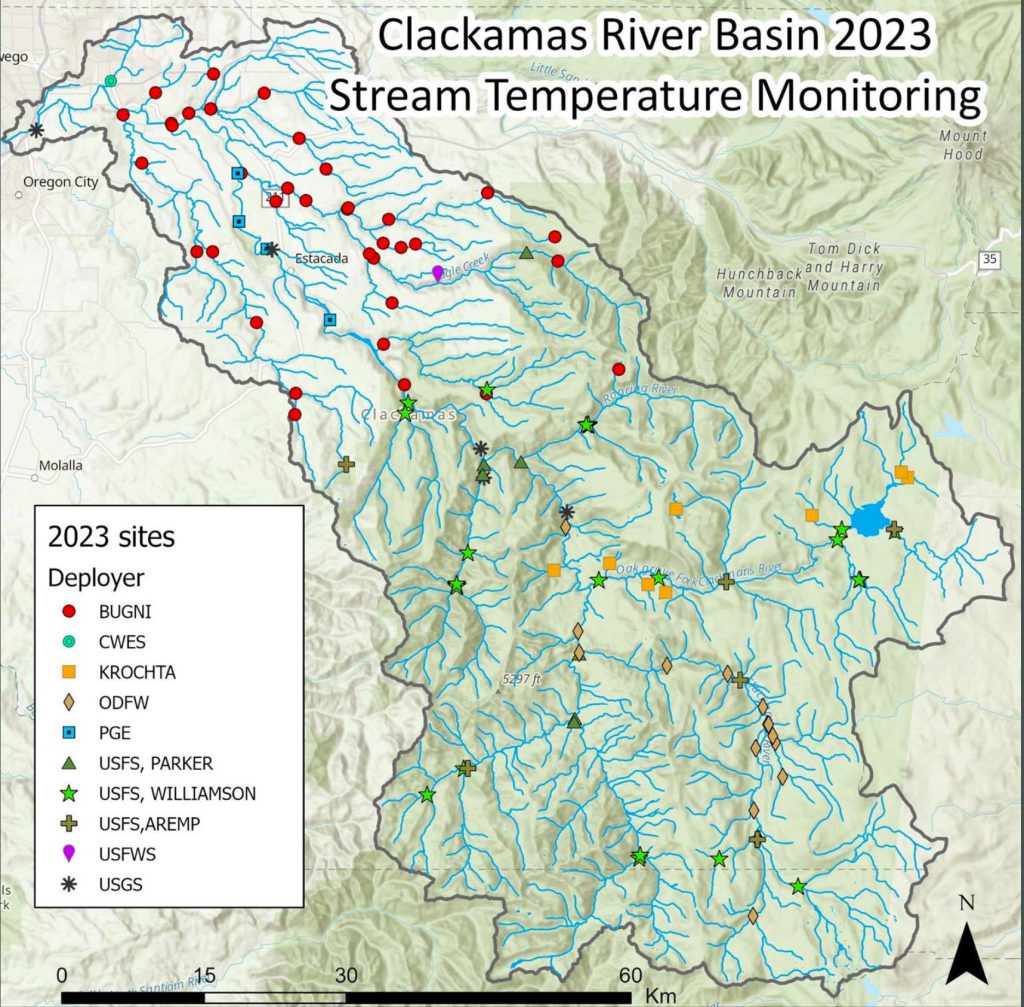Thank you to CRBC Board Member Dave Bugni for contributing this post.
The importance of temperature in defining aquatic environments is arguably second only to the presence of water. Beginning in the summer of 2021, the Clackamas River Basin Council (CRBC) in concert with Portland State University (PSU) and other organizations began to systematically deploy stream temperature sensors (data loggers) across much of the Clackamas River basin (refer to Figure 1 for the latest deployment locations). Logger deployments continued in 2022 and 2023. This is a summary of those efforts, why they are important and what new information such a study will eventually produce.

Stream temperatures in riverine systems play a critical role in the viability and survivability of aquatic life, particularly coldwater fish species such as salmonids (including steelhead and bull trout). Stream temperatures vary temporally and spatially across the basin. Causal factors for such variations include: varying solar input (which impacts both the water and surface air temperatures and is also a function of vegetation canopy cover or other shading mechanisms), stream geometry (e.g. relative size and width-to-depth ratio), aspect, channel dynamism, flow rates, groundwater input, local climate, natural disturbances (e.g. wildfire) and human-caused factors (e.g. development and water withdrawal). These factors also are closely tied to annual precipitation and geomorphological considerations (e.g. elevation and gradient). All these factors vary greatly across the basin, and when considered in combination, arguably unlike any other basin of similar size in Oregon.
The principal goal of this study will be to determine the spatial and temporal variations of stream temperature within the basin. And, specifically, how such variations relate to the abundance and composition of the native fish community. Knowing sources of coldwater in the basin will aid in determining the likely or preferred distribution of fish during their spawning and rearing life stages. In a general sense, this information can be used to identify strategic actions to protect, enhance and restore, where possible, thermal habitat and coldwater refuges. As climate change continues, locating reliable sources of cold water (on a larger scale) will help in developing public policy to implement protection measures to ensure, in a relative sense, that such sources will remain.

To create a comprehensive, basin-wide stream temperature map, since 2021 the CRBC, other organizations (PGE) and government agencies (US Geological Survey, US Forest Service, Clackamas Water Environment Services, Oregon Department of Fish & Wildlife (ODFW), and the US Fish & Wildlife Service (USFWS)) have deployed from 76 to over 100 sensors across the entire Clackamas River basin (refer to Figure 1). The data from these sensors in conjunction with reliable, historical data (where available) is being combined to produce, among other deliverables, a stream temperature map produced by PSU to depict stream temperatures in the present day as well as for two future timeframes (2050 and 2080) based upon three representative climate change scenarios from the latest Intergovernmental Panel on Climate Change (IPCC) report and integrating recent atmospheric climate modeling prepared for the basin by Portland State University. Our intent is to make this data available to all interested people and to integrate it into other studies where stream temperatures are important. A preliminary map has already been produced for current stream temperatures (refer to Figure 2 which depicts a common temperature metric – Maximum Seven Day Average Daily Maximum in degrees Celsius) and it is anticipated maps depicting stream temperature projections for 2050 and 2080 will be available late next year. This study will teach us much about our Clackamas River basin and, thus, help all of us to become better stewards of it. This study is being substantially funded through a grant from the Oregon Conservation and Recreation Fund as well as contributions of in-kind labor, cash and sensors from many individuals and organizations.
To learn more, please visit our website at PSU: https://sites.google.com/pdx.edu/clackamas-stream-temp-project/